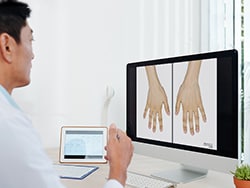Find the latest COVID-19 news and guidance in Medscape's Coronavirus Resource Center.
As is the case for virtually all medical providers, dermatologists needed to continue see their patients for both acute and routine care under the cloud of the COVID-19 pandemic. We had to learn to swim...or risk sinking. Patient and public safety concerns had to be balanced with the need for accurate diagnoses and effective treatment plans.

To this end, many dermatologists — especially those practicing in areas hardest hit by COVID-19 — have adopted a hybrid model. In-office visits are provided for dermatologic emergencies and procedures that can't wait (eg, high-risk skin cancers, abscesses for incision and drainage). Less acute issues (eg, acne, rosacea, atopic dermatitis, mild or well-controlled psoriasis, and other conditions) are triaged to telemedicine and addressed remotely.
Now, 9 months into this brave new world, what have we learned?
Teledermatology in a Nutshell
Teledermatology can be delivered through synchronous platforms (live video conferencing), store-and-forward (patient or physician-sent images), or a combination.
Some of the main issues posed by more widespread use of this modality include:
Technical constraints, such as poor image resolution, especially for skin cancer screening;
Infrastructure requirements and network connectivity (eg, patient access to high-speed internet, computer or mobile devices with adequate technological capability), which are especially problematic in rural areas and for low-income households;
Reluctance of patients, especially those with limited technology literacy, to accept remote visits;
Physical limitations of the remote skin exam (inability to palpate skin lesions, difficulty evaluating pigmented lesions without dermoscopy; inability to perform diagnostic tests, such as skin biopsies, KOH or scabies preps, and Wood lamp examination);
Unpredictable reimbursement through insurance; and
Medicolegal challenges.
There are numerous commercially available teledermatology platforms. Key considerations when choosing which platform to adopt should include compliance with the Health Insurance Portability and Accountability Act (HIPAA), integration with the electronic medical record, and ease of use for patients. Many telemedicine platforms incorporate brief previsit educational videos to help patients prepare for their remote visits.
The medicolegal concerns posed by teledermatology deserve special attention. The key point is that patients receiving remote care are entitled to the same rights of autonomy (eg, informed consent), privacy, confidentiality, and data protection as patients seen in person. Before initiating a telemedicine visit, the patient must agree to participate in the remote consultation by giving informed consent.
And considerations specific to the state or country where one practices must be kept in mind.
- 0
Medscape Dermatology © 2020 WebMD, LLC
Any views expressed above are the author's own and do not necessarily reflect the views of WebMD or Medscape.
Cite this: Graeme M. Lipper. Teledermatology in the COVID-19 Era: No Turning Back - Medscape - Dec 14, 2020.








